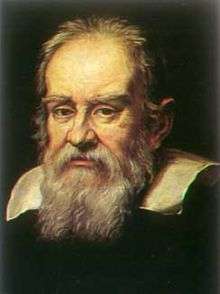And yet it moves

"And yet it moves" or "Albeit it does move" (Italian: E pur si muove or Eppur si muove [epˈpur si ˈmwɔːve]) is a phrase attributed to the Italian mathematician, physicist and philosopher Galileo Galilei (1564–1642) in 1633 after being forced to recant his claims that the Earth moves around the Sun rather than the converse during the Galileo affair.[1]
In this context, the implication of the phrase is: despite his recantation, the Church's proclamations to the contrary, or any other conviction or doctrine of men, the Earth does, in fact, move [around the Sun, and not vice versa]. As such, the phrase is used today as a sort of pithy retort implying that "it doesn't matter what you believe; these are the facts".
According to Stephen Hawking, some historians believe this episode might have happened upon Galileo's transfer from house arrest under the watch of Archbishop Ascanio Piccolomini to "another home, in the hills above Florence".[2] This other home was also his own, the Villa Il Gioiello, in Arcetri.[3]
The earliest biography of Galileo, written by his disciple Vincenzo Viviani in 1655–1656, does not mention this phrase, and records of his trial do not cite it. It would have been imprudent for Galileo to have said such a thing before the Inquisition.[4]
In 1911, the words "E pur si muove" were found on a Spanish painting which had just been acquired by an art collector, Jules van Belle, of Roulers, Belgium.[5] This painting was completed within a year or two of Galileo's death, as it is dated 1643 or 1645 (the last digit is partially obscured). The painting is obviously not historically correct, because it depicts Galileo in a dungeon, but nonetheless shows that some variant of the "Eppur si muove" anecdote was in circulation immediately after his death, when many who had known him were still alive to attest to it, and that it had been circulating for over a century before it was published.[6]
The event was first reported in English print in 1757 by Giuseppe Baretti in his book the The Italian Library:[6]:357
The moment he was set at liberty, he looked up to the sky and down to the ground, and, stamping with his foot, in a contemplative mood, said, Eppur si muove, that is, still it moves, meaning the Earth.[7]:52
The book was written 124 years after the supposed utterance and became widely published in Querelles Littéraires in 1761.[8]
References
- ↑ New Scientist, April 7, 1983. p25.
- ↑ Hawking, Stephen (2003). On the Shoulders of Giants: The Great Works of Physics and Astronomy. Running Press. pp. 396–7. ISBN 9780762416981.
- ↑ Magrini, Graziano (1 December 2010). "Villa Il Gioiello". Translated by Victor Beard. Institute and Museum of the History of Science, Florence. Retrieved 14 May 2015.
- ↑ Simons, Jay. "Did Galileo Really Say: “And Yet It Moves”?", Retrieved on 1 January 2014.
- ↑ Fahie, J.J. (1929), Memorials of Galileo (1564–1642), Leamington and London: the Courier Press, pp. 72–4
- 1 2 Drake, Stillman (2003). Galileo at Work: His Scientific Biography (Facsim. ed.). Mineola (N.Y.): Dover Publications Inc. ISBN 0486495426.
- ↑ Baretti, Giuseppe (1757). The Italian Library. Containing An Account of the Lives and Works of the Most Valuable Authors of Italy. With a Preface, Exhibiting The Changes of the Tuscan Language, from the barbarous Ages to the present Time. London: Printed for A. Millar, in the Strand. p. 52.
Text preceded by: "This is the celebrated Galileo, who was in the inquistion for six years, and put to the torture, for saying, that the Earth moved."
- ↑ A. Rupert Hall, "Galileo nel XVIII secolo," Rivista di filosofia, 15 (Turin, 1979), pp. 375–78, 83.
